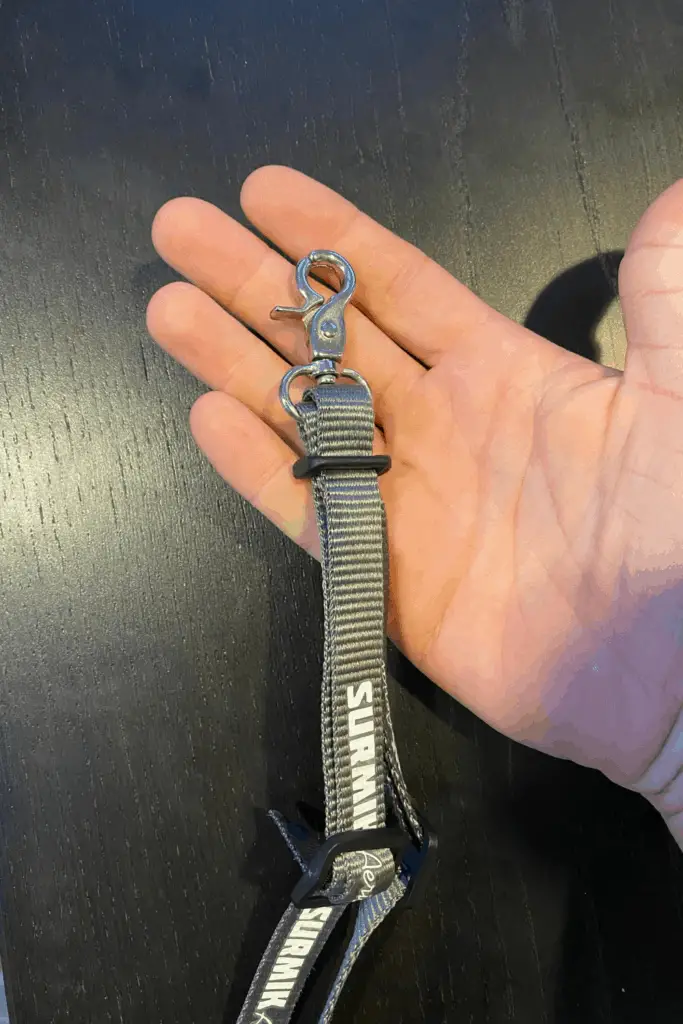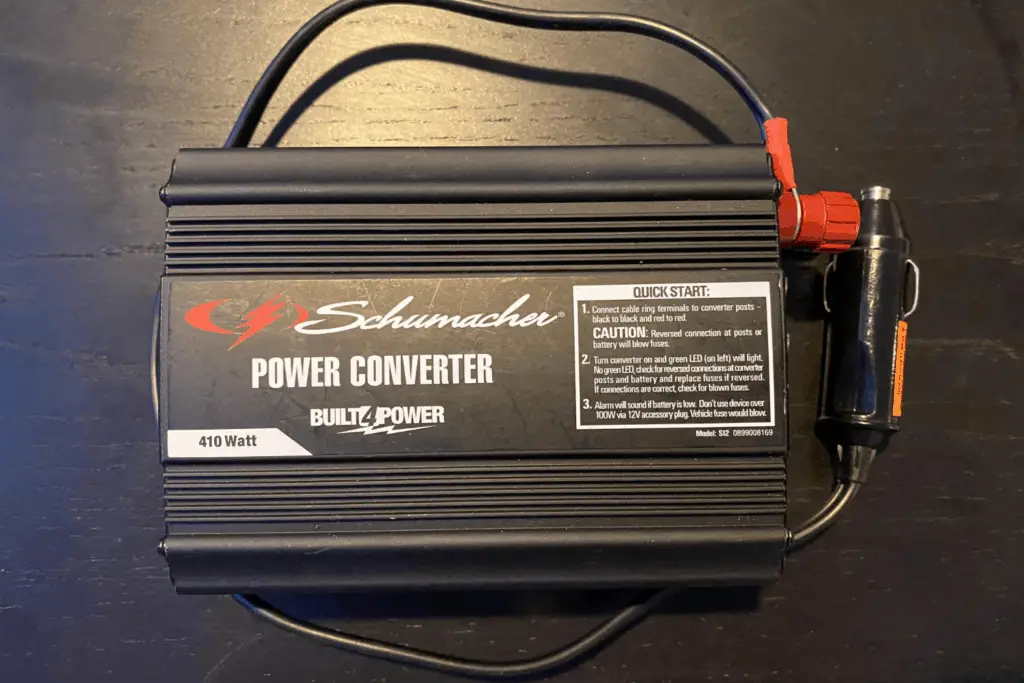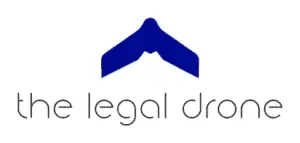People can seemingly go crazy with accessories for their drones. While all of these things are not completely necessary, I’ve purchased a bunch of these items over the years and it can be helpful to know which are worth your money and which aren’t. The following is a list of the drone accessories discussed on this page.
- Lanyards
- Landing Pads
- Cables
- Sunshades
- Bags, Backpacks and Cases
- LiPo Bags
- Drone Trackers
- Micro SD Cards
- Propellers
- Drone Apps
Lanyards
For the most part, a lanyard is a lanyard and the whole point is just to make sure that you don’t drop your controller when you’re flying. But after flying with my drones a lot, I came to have some preferences. Instead of the lanyard that just goes around your neck, the DJI Official Lanyard Necklace (Amazon Affiliate Link) that came with our Inspire 1 Pro actually let you put your arms through it and the controller clipped onto the front. If you don’t already have one, I’d recommend it because when it’s tightened on, it doesn’t seem to let the controller fall as far. The other nice thing is that the clip for the controller comes all the way off. This lets you disconnect the controller and still keep the lanyard on. If you’re flying a lot but still want to set your controller down, this is nice.
Alternatively, if you prefer the regular lanyard necklace and your drone didn’t come with one, this Adjustable Neck Lanyard (Amazon Affiliate Link) is really highly rated and is very similar to the one I have. As long as it has a clip like the picture below, you should be good on most any drone.

Cables, Power Converters and Battery Stations
Cables
This may seem like an odd one but believe it or not, you can actually buy USB cables that are the about 6 inches long. If you fly something like a Mavic, this can be really nice. This USB to USB-C cable (Amazon Affiliate Link) is perfect. There’s also a USB to Lightning for your Apple products (Amazon Affiliate Link).
No more long cables that get caught up in your other gear when you set the controller down (Am I the only one this happens to!?!). The other things that are nice about these cords is that they have the 90 degree plug, which fits really well into that side slot on your Mavic.
Power Converters
One time, not too long after I started flying drones commercially, I was flying some jobs for a larger internet service provider that required a lot of travel between 15-20 different sites. Needless to say, even with a larger number of batteries, I still ended up needing to charge my batteries between shoots. Unfortunately, the power inverter I had was rated for a really small amount of watts (less than 100, I think). So when I went to charge the batteries on the car we had rented, the charge was a trickle charge at best. It was basically useless.
The one I ended up buying was a Schumacher Power Converter (410 Watts) (Amazon Affiliate Link). I don’t think mine came with the clips for the car battery, but that’s okay because I only ever use it in the car. This power inverter works well for laptops, iPads, and drone batteries. Honestly, it still doesn’t charge the batteries as quickly as I’d like but maybe my problem is that I can see the drone batteries flashing the whole time I’m driving.

I’m hesitant to recommend another brand because everything else I’m finding is either an off-brand or has terrible reviews (not to mention I don’t have any experience with them). Suffice it to say, if you’re looking to get a power inverter, make sure you buy a name brand one and know that the higher the wattage, the more output the converter can give you. If you’re looking to charge drone batteries on the road, the more output, the faster the batteries get charge.
Sunshades
Honestly, I used to think sunshades were a joke. It felt to me more show than anything else and I didn’t want to get one for this exact reason. While I enjoy flying drones (especially for money) sometimes I think Part 107 pilots can get a little carried away and this seemed to me to be one of those places.
But boy was I wrong!
The only reason I even have sunshades (different sizes for each of my viewing devices) is because a bunch of them came with a kit that I bought. Then, not long after I purchased the drone kit, I was out flying for a client and I was looking directly into the sun. I couldn’t see anything. And then I remembered that I had my sunshades! So, I slapped one on and I could actually see the iPad. Really well! Needless to say I was sold and I use my sunshade every time I fly. It just makes things easier.
In reality, I just never paid much attention to how much I was turning my back to the sun or crouching behind a car during a flight. This just makes everything easier to see. And as far as accessories, you don’t get more bang for your buck than this. You can usually get a good sunshade for under $10.00.
As far as what kind of sunshade you should buy, there are really two types. The first kind is what I have and its basically a tri-folding piece of plastic or vinyl (usually folds flat) that covers the top and sides of your viewing device. This Rantow Sunshade (Amazon Affiliate Link) comes in a number of sizes, depending on what type of device you use to view your drone footage while flying. I recommend this type because of the fact that it lets you keep the drone in view and still make sure you’re getting the shot you need.
The second kind of sunshade is one that basically creates a square tube around your viewing device that extends from your controller to where you’d place your face. While this does provide you with the ability to basically block out all light, you’re also blocking out your ability to see the drone, which is a big no-no. My advice here is that you should really only use this type of sunshade when you have a visual observer. Someone needs to keep eyes on the drone at all times and if the person acting as the camera person doesn’t have eyes on it, the visual observer should. This Hoodman Aviator Sunshade (Amazon Affiliate Link) comes in a number of sizes and actually looks like it can be set up in a couple of different ways. This will probably be your best bet if you have times when you could use both types of sunshade, since this one comes in two pieces that can be mounted in different ways depending on whether you have a visual observer.
Bags, Backpacks and Cases
There are a number of different ways you can store your drone when you’re traveling to a location. You could use a backpack, but my business partner, who is a photographer, sold me early on the benefits of having a bag designed to carry the gear you’re using.
If flying any version of the Mavic (or really some other small, foldable drone, you really can’t do any better than this Lowepro Drone Backpack (Amazon Affiliate Link). I do not personally have one of these because I do not have a Mavic that I use. That said, Lowepro is a very well known brand in the photography community. And this backpack really has room for everything. There’s room for all kinds of batteries, chargers, cords, cables, etc. There’s even a separate compartment for your tablet and phone.
My favorite part about this type of bag is that the interior is totally customizable. Because the compartments velcro into the sides of the bag, you can basically create the compartments to fit whatever you’re carrying.
If you just need a backpack that has compartments for any number of pieces of equipment, the backpack that I’ve carried for years now is the Incase Icon Slim (Amazon Affiliate Link). I debated about this purchase for a long time because I struggled to spend so much money on a backpack. But this backpack goes everywhere with me. It’s comfortable and it has pockets for days. It’s got separate compartments for my cell phone, tablet, laptop, drone, a couple of books, poncho, writing accessories, keys, and wallet as well as a place for another bag I put inside the backpack that carries all of my cords, battery chargers, and SD cards. The laptop pocket is lined with this fake fur material and everything is super accessible. When I used to fly a Mavic, I purchased a set of hard cases (Amazon Affiliate Link) for it and put all of it in this backpack.
Another item I use on a regular basis in this backpack is a small Electronic Organizer Bag (Amazon Affiliate Link). This thing was really inexpensive (I’m pretty sure I paid under $20 for it). It comes in a bunch of colors and it has room for everything that I need. In fact, you can see in the pictures that even with all of the stuff I have in it, I even have room for a small tablet (r kindle) and a wireless mouse. This thing was a great purchase because before I had it, all of the cables and SD cards were just sort of floating around in a sipper bag or pocket. I could never find anything and never had any clue where any specific cable was.
LiPo Bags
I’m not going to sit here and say that all lipo bags are the same because they aren’t. But really, the biggest factor should be size here. How many batteries do you need to carry? Amazon has a bag by a company called DerBlue (Amazon Affiliate Link), which holds up to four 2200 mah batteries at once and still lets you charge them.
In reality though, if you’ve got a DJI drone and a backpack that lets you keep batteries in a separate compartment or pocket, this might be another accessory you can skip. Its not that DJI batteries have some special power that makes them less susceptible to fire, but unlike some other lipo batteries, the charging ports are the only real problem, and if you have them in their own compartment (and maybe even covered with tape) when you travel, this should be sufficient.
Drone Trackers
If you’re interested in drone trackers, check out my post on preventing the loss of your drone. I cover all of the various types of drone trackers, as well as the pros and cons of each.
MicroSD Cards and Hard Drives
This is another accessory that I paid little to no attention to when I first started flying drones. I had the same thought that lots of other drone pilots probably do. “An SD card is an SD card, right?”
Wrong.
First, if you stop and think about it for a second, this little piece of silicon is probably holding a lot of value for you at the moment that you’re flying. You’ve got raw pictures and videos that, hopefully, you can turn into a final product for your client.
But what if your SD card craps out on you? The footage you took is somehow corrupted or the card simply wasn’t able to write the 4K footage as fast as it was being filmed and you lost some of what you thought you had?
These are all real concerns. And while I’m not an expert, we’ve had the most success with the SanDisk Extreme Plus micro SD card. And no matter which micro SD card you go with, the most important specs you’re looking for are the read and write speed. This card can read up to 95 MB/s and write up to 90MB/s. While it’s a little bit more expensive than other SD cards, my drone business partner and I have had the unfortunate experience of losing a bunch of footage because we used a cheaper and less reliable microSD. It’s worth it to pay a few more bucks and buy a good microSD.
The other thing we typically do when we’re shooting is move a copy of the footage over to a secondary drive as soon as we land. Having multiple copies is never a bad idea and this allows you to organize the footage more easily as well.
We just use a Seagate Expansion Portable External Hard Drive (Amazon affiliate link). I know, a traditional hard drive that spins up is not as reliable as an SSD (which has no moving parts). If this is you, Seagate makes a killer (and super compact) SSD (Amazon affiliate link). It’s a smaller hard drive for the price but will definitely work for this purpose.
But we really only use this drive as a secondary place to store footage while we’re on the road. Once I get home, I typically transfer everything from either the hard drive or the microSD directly to our Google Drive.
Propellers
I don’t have any specific recommendations here, largely because it seems like most companies have done a great job coming out with propellers that a low noise. These usually come with the drone now and it seems like a waste to buy “upgrades.” If you do end up buying an upgrades propeller, maybe because your drone didn’t come with a low-noise version, just check to see if your drone manufacturer makes a low noise version of the propeller and buy that one. At this point, I think I’d also be skeptical of after-market propellers.
Drone Apps
I’ve got a whole article (that’s actually part of a drone business series) talking all about the software I use in my own drone business, including the apps I use.
Landing Pads
This is one of those categories of accessories that I don’t find to be totally necessary. When I bought my Phantom 4 Pro, it was a package deal that came with all kinds of accessories. This was one of them. I can confidently tell you that I’ve just never used it. If you’re looking for an accessory to skip, I’d say this is the one.
Most of these are basically the same: double-sided, easy to fold, one color on each side, some stakes to pin it to the ground while flying, a small carrying bag. The thing is, I just never really saw the point. I already know where I’m flying and I certainly know where I’m landing my drone. Maybe the whole point is just to show people you’re a drone pilot? And maybe it looks more professional? Either way, I just never really saw the point. I know there are other people out there that will disagree with me (maybe heartily) but I just don’t use these. That said, if you want one badly, this Drone Landing Pad (Amazon Affiliate Link) is really well reviewed and would be a great choice.

